Douglas A-4 Skyhawk
The A-4 Skyhawk was an American attack aircraft originally designed to operate from United States Navy aircraft carriers. The aircraft was designed and produced by Douglas Aircraft Corporation (later McDonnell Douglas) and was originally designated the A4D under the US Navy's pre-1962 designation system.
Fifty years after the aircraft's first flight, and having played key roles in Vietnam, the Falklands and Yom Kippur wars, some of the nearly 3,000 Skyhawks produced remain in service with several air arms around the world, including active duty on a carrier.
Design and development
The Skyhawk was designed by Douglas' Ed Heinemann in response to a US Navy call for a jet-powered attack aircraft to replace the A-1 Skyraider. Heinemann opted for a design that would minimize size, weight and complexity. The result was an aircraft that weighed only half of the Navy's specification and had a wing so compact that it did not need to be folded for carrier stowage. The diminutive Skyhawk soon received the nicknames "Scooter," "Bantam Bomber", "Tinker Toy Bomber", and, on account of its nimble performance, "Heinemann's Hot-Rod".

The aircraft is of conventional post-World War II design, with a low-mounted delta wing, tricycle undercarriage, and a single turbojet engine in the rear fuselage, with intakes on the fuselage sides. The tail is of cruciform design, with the horizontal stabilizer mounted above the fuselage. Armament consisted of two 20 mm Colt Mk 12 cannon, one in each wing root, with 200 rounds per gun, plus a large variety of bombs, rockets and missiles carried on a hardpoint under the fuselage centerline and hardpoints under each wing (originally one per wing, later two).

The design of the A-4 is a good example of the virtues of simplicity. The choice of a delta wing, for example, combined speed and maneuverability with a large fuel capacity and small overall size, thus not requiring folding wings, albeit at the expense of cruising efficiency. The leading edge slats are designed to drop automatically at the appropriate speed by gravity and air pressure, saving weight and space by omitting actuation motors and switches. Similarly the main undercarriage did not penetrate the main wing spar, designed so that when retracted only the wheel itself was inside the wing and the undercarriage struts were housed in a fairing below the wing. The wing structure itself could be lighter with the same overall strength and the absence of a wing folding mechanism further reduced weight. This is the opposite of what can often happen in aircraft design where a small weight increase in one area leads to a compounding increase in weight in other areas to compensate, leading to the need for more powerful, heavier engines and so on in a cycle.[1][2][3]

The A-4 pioneered the concept of "buddy" self air-to-air refueling. This allows the aircraft to supply others of the same type, eliminating the need of dedicated tanker aircraft - a particular advantage for small air arms or when operating in remote locations. A designated supply A-4 would mount a center-mounted "buddy store", a large external fuel tank with a hose reel in the aft section and an extensible drogue refueling bucket. This aircraft was fuelled up without armament and launched first. Attack aircraft would be armed to the maximum and given just enough fuel allowable by maximum take-off weight limits. Once airborne, they would then proceed to top up their fuel tanks from the tanker using the A-4's fixed re-fueling probe on the starboard side of the aircraft nose. They could then sortie with both full armament and fuel loads. While rarely used in US service since the KA-3 Skywarrior tanker became available, the F/A-18E/F Super Hornet includes this capability, with a view to the imminent retirement of dedicated tankers.

The A-4 was also designed to be able to make an emergency landing, in the event of a hydraulic failure, on the two drop tanks nearly always carried by these planes. Such landings resulted in only minor damage to the nose of the aircraft which could be repaired in less than an hour. Ed Heinemann is credited with having a large "K.I.S.S." sign put up on the wall of the drawing office when the aircraft was being designed. Whether this is true, the A-4 certainly is a shining example of the application of that principle to aircraft design.
The Navy issued a contract for the type on 12 June 1952, and the first prototype first flew on 22 June 1954. Deliveries to Navy and US Marine Corps squadrons commenced in late 1956.
The Skyhawk remained in production until 1979, with a total of 2,960 aircraft built, including 555 two-seat trainers.
Operational history
United States
The Skyhawk proved to be one of the most popular US naval aircraft exports of the postwar era. Due to its small size, it could be operated from the older, smaller World War II-era aircraft carriers still used by many smaller navies during the 1960s. These older ships were often unable to accommodate newer USN fighters such as the F-4 Phantom II and F-8 Crusader, which were faster and more capable than the A-4, but significantly larger and heavier than older naval fighters.
The US Navy began removing the aircraft from its front line squadrons in 1967, with the last retiring in 1975.

The Marines would pass on the Navy's replacement, the A-7 Corsair II, instead keeping Skyhawks in service, and ordering the new A-4M. The last USMC Skyhawk was delivered in 1979, and were used until the mid-1980s before they were replaced by the equally small, but more versatile STOVL AV-8 Harrier II.
The Diamondbacks of VMA-131,Marine Aircraft Group 49 retired their last four OA-4Ms on 22 June 1994. LtCol. George "Eagle" Lake III (CO), Major John "Baja" Rufo (XO), Captain Dave "Yoda" Hurston and Major Mike "Struts" Volland flew a final official USMC A-4 sortie during the A-4 Standdown Ceremony. Trainer versions of the Skyhawk remained in Navy service, however, finding a new lease on life with the advent of adversary training, where the nimble A-4 was used as a stand-in for the Mikoyan-Gurevich MiG-17 in dissimilar air combat training (DACT). It served in that role until 1999.
The A-4's nimble performance also made it suitable to replace the F-4 Phantom II when the Navy downsized their aircraft for the Blue Angels demonstration team until the availability of the F/A-18 Hornet in the 1980s. The last US Navy Skyhawks, TA-4J models belonging to composite squadron VC-8, remained in military use for target-towing and as adversary aircraft for combat training at Naval Air Station Roosevelt Roads. They were officially retired on 3 May 2003.
Skyhawks were well loved by their crews for being tough and agile. These attributes, along with its low purchase and operating cost as well as easy maintenance, have contributed to the popularity of the A-4 with American and international armed forces. Besides the US, at least three other nations used A-4 Skyhawks in combat.
Vietnam War
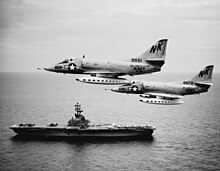
Skyhawks were the Navy's primary light bomber over both North Vietnam during the early years of the Vietnam War while the USAF was flying the supersonic F-105 Thunderchief. They would be supplanted by the A-7 Corsair II in the Navy light bomber role. Skyhawks carried out some of the first air strikes by the US during the conflict and a Marine Skyhawk is believed to have dropped the last US bombs on the country. Notable pilots like Lt. (Jg) Everett Alvarez, (Cdr) Hugh Magee, John McCain, and Vice Admiral James Stockdale flew the Skyhawk. On 1 May 1967, an A-4C Skyhawk piloted by LCDR Theodore R. Swartz from VA-76, based on the carrier USS Bon Homme Richard, shot down a Soviet-built Mikoyan-Gurevich MiG-17 with an unguided Zuni rocket in the Skyhawk's only air-to-air victory of the war.[4]
The first loss of an A-4 occurred on 5 August 1964, when LTJG (USN) Everett Alvarez, VA-144, flying from the USS Constellation, was shot down while attacking enemy torpedo boats in North Vietnam. LTJG Alvarez safely ejected after being hit by AAA fire, and became the first US Naval POW of the war; he was released as a POW on 12 February 1973. The last A-4 to be lost in the Vietnam War occurred on 26 September 1972, when USMC pilot Capt. James P. Walsh, VMA-211, flying from his land base at Bien Hoa, South Vietnam, was hit by ground fire near An Loc. An Loc was one of the few remaining hotly contested areas during this time period, and Capt. Walsh was providing close air support (CAS) for ground troops in contact (land battle/fire fight) when his A-4 was hit, catching fire, forcing him to eject. Rescue units were sent, but the SAR helicopter was damaged by enemy ground fire, and forced to withdraw. Capt. Walsh, after safely ejecting, had landed within NVA (North Vietnamese Army) positions, and had become a POW as soon as his feet had touched the ground. Capt. Walsh was the last US Marine to be taken prisoner during the war, and was released as a POW on 12 February 1973.
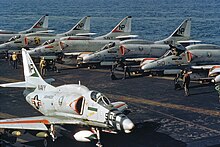
During the war, 362 A-4/TA-4F Skyhawks were lost to all causes. The US Navy lost 271 A-4s, the US Marine Corps lost 81 A-4s and ten TA-4Fs. A total of 32 A-4s were lost to surface-to-air missiles (SAMs), and one A-4 was lost in aerial combat to a MiG-17 on 25 April 1967.
On 29 July 1967, the aircraft carrier USS Forrestal (CV-59) was conducting combat operations in the Gulf of Tonkin during the Vietnam War. A Zuni rocket misfired, knocking off an external tank on an A-4. Fuel from the leaking tank caught fire creating a massive conflagration that burned for hours, killing 134 sailors, and injuring 161. (See 1967 USS Forrestal fire.)
Israel
In the late 1960s and 1970s, Israeli Air Force Skyhawks would be the primary ground attack aircraft in the War of Attrition and the Yom Kippur War. They cost only 1/4 what a Phantom II cost and carried more bombs and had longer range than the air superiority fighters they replaced.[5] In May 1970, an Israeli Skyhawk piloted by Col. Ezra Dotan also shot down a MiG-17 with unguided rockets, over south Lebanon. The Skyhawks bore the brunt of losses to sophisticated SA-6 Gainful missile batteries. They have been replaced by F-16s but are still used for pilot training.
Argentina
Argentina was not only the first foreign user of the Skyhawk but also one of the largest with nearly 130 A-4s delivered since 1965. The Argentine Air Force received 25 A-4Bs in 1966 and another 25 in 1970, all refurbished in the United States by Lockheed Service Co. prior their delivery as A-4P although they were still locally known as A-4B. They had three weapon pylons and served in the 5th Air Brigade (Spanish: V Brigada Aerea). In 1976, another order was made for 25 A-4Cs to replace the F-86 Sabres still in service in the 4th Air Brigade (Spanish: IV Brigada Aerea). They were received as is and refurbished to flight status by the air force technicians at Río Cuarto, Cordoba. They had five weapon pylons and could use AAM AIM-9B Sidewinders.
The Argentine Navy also bought the Skyhawk in the form of 16 A-4B plus two for spare parts, modified with five weapon pylons and to carry AIM-9B Sidewinders , known as A-4Q. They were received in 1971 to replace F9F Panther and F9F Cougar in use from the aircraft carrier ARA Veinticinco de Mayo by the 3rd Fighter/Attack Squadron (Spanish: 3ra Escuadrilla Aeronaval de Caza y Ataque).
The United States placed an embargo of spare parts in 1977 due to the Dirty War (which was lifted in the 1990s under Carlos Menem's presidency when Argentina became a Major non-NATO ally). In spite of this, A-4s still served well in the 1982 Falklands War where they achieved success against the Royal Navy.
Falklands War
During the 1982 conflict, armed with iron bombs and lacking any electronic or missile self defense, Argentine Air Force Skyhawks sank HMS Coventry (D118) and HMS Antelope (F170) as well as producing heavy damage to several others: RFA Sir Galahad (1966) (which was subsequently scuttled as a war grave), HMS Glasgow (D88), HMS Argonaut, HMS Broadsword and RFA Sir Tristram. Argentine Navy A-4Qs, flying from Río Grande, Tierra del Fuego naval airbase, also played a role in the bombing attacks against British ships, destroying HMS Ardent (F184).[6]
In all, 22 Skyhawks (ten A-4B, nine A-4C and three A-4Q) were lost to all causes in the six weeks-long war.
After the war, Air Force A-4Bs and A-4Cs survivors were upgraded under the Halcon program with 30 mm guns, AAM missiles and other minor details and merged into the 5th Air Brigade. All were withdrawn from use in 1999 and replaced with 36 examples of the much improved OA/A-4AR Fightinghawk. Several TA-4J and A-4E airframes were also delivered under the A-4AR program mainly for spare parts use.
In 1983, the United States vetoed delivery by Israel of 24 A-4H for the Argentine Navy as the A-4Q replacement which were finally retired in 1988.
Kuwait
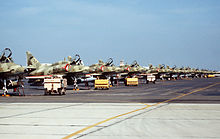
More recently, Kuwaiti Air Force Skyhawks fought in 1991, during Operation Desert Storm. Of the 36 that were delivered to Kuwait in 1970s, 23 survived the conflict and the Iraqi invasion, with only one being destroyed in combat. The remaining Kuwaiti Skyhawks were then sold to Brazil.[7]
Training/Adversary role
The A-4 Skyhawk was introduced to a training role in the two-seat TA-4J configuration replacing the TF-9J Cougar as the advanced jet trainer The TA-4J served as the advanced jet trainer in white and orange markings for decades until being replaced by the T-45 Goshawk. Additional TA-4J Skyhawks were assigned to Instrument Training RAGs at all the Navy master jet bases under RCVW-12 and RCVW-4. The Instrument RAGs initially provided jet transition training for Naval Aviators during the time period when Naval Aviation still had a great number of propellor driven aircraft and also provided annual instrument training and check rides for Naval Aviators. The assigned TA-4J models were installed with collapsable hoods so the aviator under training had to demonstrate instrument flying skills without any outside reference. These units were VF-126 at NAS Miramar, VA-127 (later VFA-127) at NAS Lemoore, VF-43 at NAS Oceana and VA-45 (later VF-45) at NAS Key West.

Additional single-seat A-4 Skyhawks were also assigned to composite squadrons (VC) worldwide to provide training and other services to deployed units. There were VC-1 at NAS Barber's Point, VC-2 at NAS Miramar, VC-5 at Cubi point, Republic of Philippines, VC-8 at NAS Roosevelt Roads, Puerto Rico, VC-10 at Guantanamo bay, Cuba, VC-12 (later VFC-12) at NAS Oceana and VC-13 at NAS Miramar.
With renewed emphasis on Air Combat Maneuvering (ACM) training brought on with the establishment of the Navy Fighter Weapons School (TOPGUN) in 1968, the availability of A-4 Skyhawks in both the Instrument RAGs and Composite Squadrons at the Master Jet Bases presented a ready resource of the nimble Skyhawks that had become the TOPGUN preferred surrogate for the MiG-17. At the time, the F-4 Phantom was just being exploited to its full potential as a fighter and had not performed as well as expected against the smaller North Vietnamese MiG-17 and MiG-21 opponents. TOPGUN introduced the notion of dissimilar air combat training (DACT) using the A-4E in the striped "Mongoose" configuration with fixed slats.
The small size of the Skyhawk and superb low speed handling in the hands of a well trained aviator made it ideal to teach fleet aviators the finer points of DACT. The squadrons eventually began to display vivid threat type paint schemes signifying their transition into the primary role of Adversary training. To better perform the Adversary role, single-seat A-4E and F models were introduced into the role, but the ultimate Skyhawk was the "Super Fox," which was equipped with the uprated J52-P-408 engine similar to the configuration used by the Blue Angels.
The surplus of former USMC Skyhawks resulted in A-4M versions being used by both VF-126 and TOPGUN. Even though the A-4 was augmented by the F-5E, F-21 (Kfir), F-16 and F/A-18 in the Adversary role, the A-4 remained a viable threat surrogate until it was retired by VF-43 in 1993 and shortly thereafter by VFC-12. The last A-4 fleet operators were VC-8 which retired their Skyhawks in 2003.
Variants



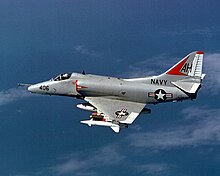


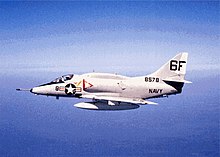


- Prototypes
- XA4D-1: Prototype
- YA4D-1 (YA-4A, later A-4A): Flight test prototypes and pre-production aircraft.
- A-4A
- A4D-1 (A-4A): Initial production version, 166 built
- A-4B
- A4D-2 (A-4B): Strengthened aircraft and added air-to-air refueling capabilities, improved navigation and flight control systems, provision for AGM-12 Bullpup missile, 542 built.
- A-4P: Remanufactured A-4Bs sold to Argentine Air Force known as A-4B by the Argentines.
- A-4Q: Remanufactured A-4Bs sold to Argentine Navy.
- A4D-3: Proposed advanced avionics version, none built.
- A-4C
- A4D-2N (A-4C): Night/adverse weather version of A4D-2, with AN/APG-53A radar, autopilot, LABS low-altitude bombing system. Wright J65-W-20 engine with 8,200 lbf (36.5 kN) takeoff thrust, 638 built.
- A-4L: 100 A-4Cs remanufactured for Navy Reserve squadrons.
- A-4S: 40 A-4Cs remanufactured for Republic of Singapore Air Force.
- A-4SU Super Skyhawk: This is an extensively modified and updated version of the A-4S, exclusively for the Republic of Singapore Air Force (RSAF), fitted with a General Electric F404 non-afterburning turbofan engine, and modernized electronics.
- TA-4S: seven trainer versions of the above. Different from most Skyhawk trainers in that they have a second canopy for instructor, rather than seating student and instructor under one long canopy.
- TA-4SU: This is an extensively modified and updated version of the TA-4S to A-4SU standard.
- A-4PTM: 40 A-4Cs and A-4Ls refurbished for Royal Malaysian Air Force, incorporating many A-4M features.
- TA-4PTM: Small number of trainer versions of above.
- A4D-4: Long-range version with new wings cancelled; A-4D designation skipped to prevent confusion with A4D
- A-4E
- A4D-5 (A-4E): Major upgrade, including new Pratt & Whitney J52-P-6A engine with 8,400 lbf (37 kN) thrust, strengthened airframe with two more weapon pylons (for a total of five), improved avionics, with TACAN, Doppler navigation radar, radar altimeter, toss-bombing computer, and AJB-3A low-altitude bombing system. Many later upgraded with J52-P-8 engine with 9,300 lbf (41 kN) thrust; 499 built.
- TA-4E: two A-4Es modified as prototypes of a trainer version.
- A4D-6: Proposed version, none built.
- A-4F
- A-4F: Refinement of A-4E with extra avionics housed in a hump on the fuselage spine (this feature later retrofitted to A-4Es and some A-4Cs) and more powerful J52-P-8A engine with 9,300 lbf (41 kN) thrust, later upgraded in service to J52-P-408 with 11,200 lbf (50 kN), 147 built. Some served with Blue Angels acrobatic team from 1973 to 1986.
- TA-4F: Conversion trainer - standard A-4F with extra seat for an instructor, 241 built.
- OA-4M: 23 TA-4Fs modified for Forward Air Control duties for the USMC.
- EA-4F: four TA-4Fs converted for ECM training.
- TA-4J: Dedicated trainer version based on A-4F, but lacking weapons systems, and with down-rated engine, 277 built new, and most TA-4Fs were later converted to this configuration.
- A-4G: eight aircraft built new for the Royal Australian Navy with minor variations from the A-4F in particular they were not fitted with the avionics "hump". Subsequently, eight more A-4Fs were modified to this standard for the RAN. Significantly the A-4G were modified to carry four underwing Sidewinder AIM-9B missiles increasing their Fleet Defense capability.[8]
- TA-4G: two trainer versions of the A-4G built new, and two more modified from TA-4Fs.
- A-4H: 90 aircraft for the Israeli Air Force based on the A-4F. Used 30 mm DEFA cannon with 150 rounds per gun in place of US 20 mm guns. Later, some A-4Es later locally modified to this standard. Subsequently modified with extended jetpipes as protection against heat-seeking missiles.
- TA-4H: 25 trainer versions of the above. These remain in service, and are being refurbished with new avionics and systems for service till at least 2010.
- A-4K: ten aircraft for Royal New Zealand Air Force. In the 1990s these were upgraded under Project KAHU with new radar and avionics, provision for AGM-65 Maverick, AIM-9 Sidewinder, and GBU-16 Paveway II laser-guided bomb. The RNZAF also rebuilt an A-4C and ten A-4Gs to A4K standard.
- TA-4K: four trainer versions of the above. A fifth was later assembled in NZ from spare parts. The sale of ex-RNZAF A-4K and TA-4K aircraft to a private US flight training firm was announced in September 2005[citation needed] but this deal seems to not have taken place as of January 2008.[citation needed]
- A-4M
- A-4M: Dedicated Marine version with improved avionics and more powerful J52-P-408a engine with 11,200 lbf (50 kN) thrust, enlarged cockpit, IFF system. Later fitted with Hughes AN/ASB-19 Angle Rate Bombing System (ARBS) with TV and laser spot tracker, 158 built.
- A-4N: 117 modified A-4Ms for the Israeli Air Force.
- A-4KU: 30 modified A-4Ms for the Kuwaiti Air Force. Brazil purchased 20 of these second-hand and redesignated them AF-1. Now used in Brazilian Navy on carrier duty.
- TA-4KU: three trainer versions of the above. Brazil purchased some of these second-hand and redesignated them AF-1A.
- A-4AR: 36 A-4Ms refurbished for Argentina. Known as Fightinghawk.
- TA-4R: Refurbished two-seat training version for Argentina.
- A-4Y: Provisional designation for A-4Ms modified with the ARBS. Apparently never adopted by the US Navy or Marine Corps.
Operators
- Indonesian Air Force: All 33 have been retired and replaced with 4 new Flankers in 2003, they are however in reserve and ready if needed.
Specifications (A-4F Skyhawk)

Data from [1]
General characteristics
- Crew: 1 (2 in TA-4J,TA-4F,OA-4F)
- Airfoil: NACA 0008-1.1-25 root, NACA 0005-0.825-50 tip
- Fuel capacity: 5,200 lbs
Performance
- Thrust/weight: 0.51
Armament
- Guns: 2× 20 mm (0.787 in) Colt Mk 12 cannon, 100 rounds/gun
- Missiles: 4× AIM-9 Sidewinder
AGM-45 Shrike ARM (Anti-Radiation Missile), AGM-65 Maverick ASM (Air-to-Surface Missiles), AGM-62 Walleye Glide bomb, AGM-12 Bullpup ASM (Air-to-Surface Missiles), Rockeye Mk.20 Cluster Bomb Unit, Rockeye Mk.7/APAM-59 Cluster Bomb Unit, Mk.81 (250 lb) and Mk.82 (500 lb) free fall or retarded bombs, various tactical nuclear missiles and bombs, Mk.76 Practice Bombs
- Bombs: 9,900 lb (4,490 kg) on five external hardpoints
Popular culture
The Skyhawk has been featured in some movies, most notably as the aggressor aircraft used by instructors in the movie Top Gun. It is also featured heavily in the anime series Area 88, and in the movie and novel The Sum of All Fears, where a Skyhawk's downing is a pivotal plot point.
See also
Related development
Aircraft of comparable role, configuration, and era
Related lists
Image gallery
-
A TA-4K Skyhawk at the Ohakea wing of the RNZAF Museum 2007.
-
A US Navy TA-4J Skyhawk of TW-2 assigned to USS Lexington, 1991
References
Notes
- ^ Air Victory Museum Retrieved: 31 October 2007.
- ^ Museum of FlightRetrieved: 31 October 2007.
- ^ National Museum of Naval Aviation - Collections - Aircraft - SKYHAWK (A4D/A-4/TA-4) Retrieved: 31 October 2007.
- ^ Grossnick and Armstrong 1997
- ^ A-4 Skyhawk in IAF service
- ^ See Gordon Smith's website for complete reference.
- ^ A-4 Skyhawk
- ^ Royal Australian Navy Skyhawk
Bibliography
- Drendel, Lou. A-4 Skyhawk in Action. Carrollton, Texas: Squadron/Signal Publications, 1973. ISBN 0-89747-010-9.
- Grossnick, Roy A. and William J. Armstrong. United States Naval Aviation, 1910 – 1995. Annapolis, Maryland: Naval Historical Center, 1997. ISBN 0-16049-124-X.
- Hobson, Chris. Vietnam Air Losses, USAF/USN/USMC, Fixed-Wing Aircraft Losses in Southeast Asia, 1961-1973. North Branch, Minnesota: Specialty Press, 2001. ISBN 1-85780-1156.
- Kilduff, Peter. Douglas A-4 Skyhawk. London: Osprey Publishing, 1983. ISBN 0-85045-529-4.
- Parsons, Dave and Derek Nelson. Bandits, Pictorial History of American Adversarial Aircraft. St. Paul, Minnesota: Motorbooks International, 1993. ISBN 0-87938-623-1.
- Peacock, Lindsey. A-4 Skyhawk (Osprey Combat Aircraft series). London: Osprey Publications, 1987. ISBN 0-85045-817-X.
- Wilson, Stewart. Phantom, Hornet and Skyhawk in Australian Service. Canberra, Australia: Aerospace Publications, 1993. ISBN 1-87567-103-X.


